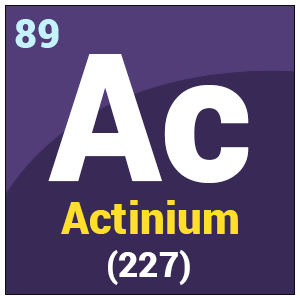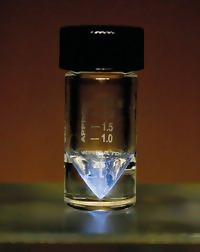Actinium
What is Actinium?
Actium is the 89th element on the periodic table and is donned with the symbol Ac. Actinium is the element for which the actinide series is named and all of these elements share common traits such as high levels of radioactivity. The actinide series runs from elements 89-113. Many of these elements cannot be found in nature. Like all actinides, actinium is a metal. It appears silvery-white and is radioactive. This radioactivity makes actinium glow an eerie blue. Due to high cost and rarity actinium has no real industrial uses but does see some use in radiation therapy for the targeting and destruction of cancer cells.
 Actinium in the Periodic Table
Actinium in the Periodic Table
Atomic number: 89
Symbol: Ac
Group: 3
Period: 7
Number of Protons: 89
Number of Electrons: 89
Number of Neutrons: 138
Atomic Radius: 200pm
Atomic Mass: 227u
Number of Isotopes: 32
Actinides are all the elements between actinium and lawrencium. Actinium is the first element in this group and carries the namesake for it. The other elements in the series were compared to, and deemed similar to, actinium, and it was used as a basis in the discovery of other elements in the series.
Properties of Actinium
Actinium is a soft silvery-white radioactive metal. In nature actinium only occurs in its 227Ac and 228Ac isotopes. Actinium is only found naturally in trace amounts inside of uranium ores. As a radioactive element actinium corrodes quite rapidly. Actinium does have moderate thermal and electrical conductivity. Actinium is an actinide, which are radioactive metals and are generally light in color and soft and malleable. Due to its radioactivity actinium is obviously not very stable and its isotopes have a large variety of half-lives. This radioactivity also poses threats to humans and actinium must be handled with and experimented on with great care.

“Actinium” by Simon Moorhouse is licensed under CC BY 2.0
Physical Properties of Actinium
The soft silvery-white metal that is actinium does also have another very striking trait; it glows blue. This glow is due to the elements radioactivity and gives the element a somewhat eerie feel. But in solution actinium is colorless.

“Purified 225Ac emitting Cerenkov luminescence” by Oak Ridge National Laboratory is licensed under CC BY 2.0
Melting Point: 1050oC
Boiling Point: 3197oC
Density: 10.07g/cm3
Phase at Room Temperature: Solid
Chemical Properties of Actinium
In terms of stability actinium is rather variable. The naturally occurring isotopes have half lives of 21.77 years and 6.15 hours. This is obviously a huge disparity and this is only in two of the 32 isotopes. Due to its extreme radioactivity not many compounds of actinium are known and thus it is difficult to determine exactly how actinium behaves with both acids and bases. Actinium is not stable but has a difficult time bonding as well, this is again due to its radioactivity. However, actinium does readily react with oxygen to form an actinium oxide layer which prevents further oxidation. Actinium is also not very electronegative. As with most actinides and lanthanides, actinium is generally found in the +3-oxidation state.
Oxidation States: +2, +3
Specific Heat: 10.5 kJ/mol
Electronegativity: 1.1 Pauling Scale
Heat of Fusion: 14 kJ/mol
Heat of Vaporization: 400 kJ/mol
Electron Configuration: [Rn] 7s26d1
Isotopes
Actinium has 32 known isotopes. As mentioned earlier only two of these occur naturally. The others have only been observed in a lab. The caveat to actinium is its rarity and scarcity alongside its radioactivity. The combination of all these things leave basically no practical use for any of the known isotopes. The stability of the isotopes also varies greatly with the shortest half-life being 52ms and the longest being nearly 22 years.
Alloys of Actinium
Actinium does not form any known alloys. This is due to its extreme instability and radioactivity.
Occurrence and Abundance of Actinium
Naturally occurring actinium is only found in two places, ores of uranium and thorium. Inside of these ores, actinium is only found in very trace amounts, if at all. For reference, one ton of uranium contains only 0.2mg of actinium. This number is even smaller in thorium. To be synthesized, actinium is most commonly created from the irradiation of radium. This process is very inefficient and only yields an approximately 2% yield of the weight of radium to actinium. The various abundances of actinium are unknown at this time but it can be extrapolated that it is an extremely low percentage of the universe’s elements.
Uses of Actinium
Actinium is a very scarce element. Actinium can only be found naturally inside uranium and thorium ores and the process of separation and purification is difficult and expensive. This, coupled with its extreme radioactivity, leads it to be quite expensive to purchase and maintain, leading to very few practical uses.
General Uses of Actinium
As of now actinium has no general or industrial uses.
Scientific Uses of Actinium
Actinium is being studied in medicine for use in cancer treatment. It can be used in conjunction with other elements, or stand alone, as an agent for radiation therapy. Due to 225Ac’s longer half life of 10 days (compared to other usable elemental isotopes), it allows a longer observation window in targeted alpha therapy. Which is essentially the seeking and destruction of cancerous cells.
Notable Compounds
Due to its intense radioactivity actinium forms very few compounds. Actinium oxide can be obtained through the super heating of the hydroxide or oxalate in a vacuum. Some halides can also be formed with actinium, including actinium trifluoride, and actinium trichloride. However, both of these must be formed in a lab and under extreme and specific conditions.
Discovery of Actinium
The discovery of actinium was surrounded in a bit of confusion for a while. In 1899, French chemist Adre-Louis Debierne announced the discovery of a new element. Using pitchblende residue left by Marie and Pierre Curie, Debierne described his new element as being similar to titanium and thorium. Another chemist, Friedrich Oskar Giesel of Germany, independently discovered the element in 1902. He realized this element was similar to lanthanum and named it emanium in 1904. After various studies were performed on the substance’s half-lives it was determined that Debierne’s name should stay as it had seniority over Geisel’s. However, this caused some issues as Debierne had provided some conflicting chemical properties of the new element at different times, giving rise to the notion that perhaps Debierne had misrepresented his findings or did not truly discover this element at all. After many studies conducted on Debierne’s work in the 70’s, it was discovered that based on Debierne’s findings and descriptions of this new element that he had more likely discovered protactinium instead of actinium. This led some people to advocate for Giesel to be named as the sole discoverer. It was, however, determined that hindsight judgement of early publications did not lead to enough evidence for the refutation of Debierne’s work and it could not be proven that Debierne’s work did not contain actinium. Debierne is most often credited with the discovery because of this.
Interesting Facts about Actinium
- Naturally occurring Actinium has absolutely no use in industry or science, only man-made isotopes can be used in medicine as of now
- Hot cell shielding is necessary when dealing with actinium amounts as small as a gram due to the intense gamma radiation emitted
- The discoverer of actinium, Debierne, lost interest in the element and stopped studying it soon after its discovery
Actinium in the Future
Due to its high cost and extreme radioactivity it seems rather unlikely that actinium will ever see large scale commercial or scientific use any time soon.